“The Return of the Archons”
Written by Gene Roddenberry and Boris Sobelman
Directed by Joseph Pevney
Season 1, Episodes 22
Production episode 6149-22
Original air date: February 9, 1967
Stardate: 3156.2
Captain’s log. Sulu and O’Neil have been sent down to Beta III, dressed in native clothes, searching for evidence of the U.S.S. Archon, which disappeared there a hundred years earlier. They’re being chased by guys in monk’s robes. Sulu calls for beam-out, but O’Neil is panicking and runs away. And before Sulu can be transported up, one of the guys in robes hits him with a stick. When he materializes, he’s spouting gibberish about being of the body, looking for Archons, paradise, and so on, all with a goofy smile on his face.
Kirk, Spock, McCoy, Lieutenant Lindstrom (the ship’s sociologist), and two security guards, Leslie and Galloway, beam down, also in native attire. Spock observes that everyone’s as vacantly content as Sulu is now. A native asks if they’re in for the festival, and they say they are, and they don’t have accommodations for it yet.
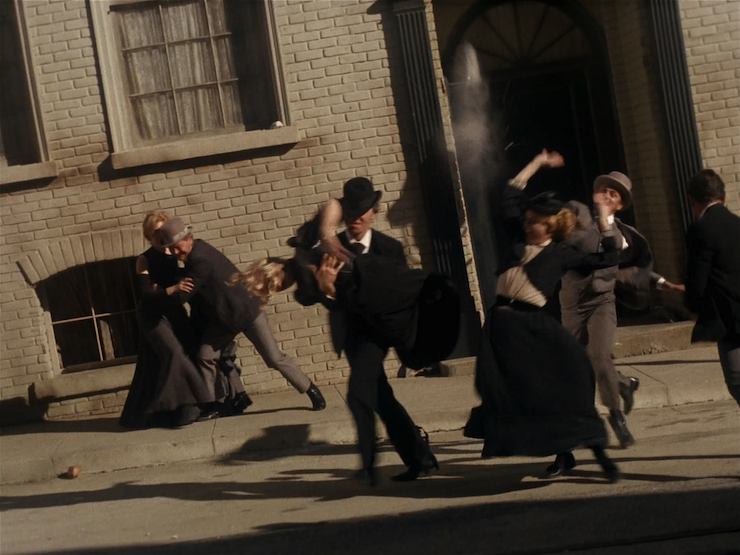
And then the clock strikes six, which is apparently “red hour,” and everyone goes nuts, tearing their clothes, attacking each other, kissing each other, throwing rocks, and just generally rioting. The landing party runs into a building, where they’re met by three older men, Reger, Hacom, and Tamar. Hacom is suspicious of them, because they’re not participating in red hour. Tamar thinks that they simply have different ways in “the valley” (where they’re pretending they’re from), but Hacom says that Landru is all-seeing and they have lawgivers in the valley, too.
Reger brings them to a room, and Kirk questions Reger about Landru, a name they’ve heard a lot, but the very notion of questioning Landru puts Reger in a panic.

They stay the night. At six o’clock the following morning, everyone stops rioting and wanders the streets as if nothing has happened. Reger’s daughter, Tula, is having traumatic aftereffects. McCoy tends to her, but then Hacom returns with two lawgivers, the guys in robes. First they kill Tamar for disobedience, then they inform the landing party that they are not of the body and they will be absorbed. Kirk refuses, which confuses the hell out of the lawgivers, who have never encountered disobedience before. They start communing, which according to Reger means they have time to get away to somewhere safe.
But then everyone stops moving. Reger says it’s Landru summoning the body. As one, everyone picks up a rock or a stick or something and moves on the landing party as a single unit. The landing party holds them off with phasers on stun (it helps that the people move really slowly). One of the people going after them is O’Neil, who is now stunned. Reger says to leave him, as Landru will be able to trace them through him, but Kirk insists on taking him along, so the two security guards carry him.
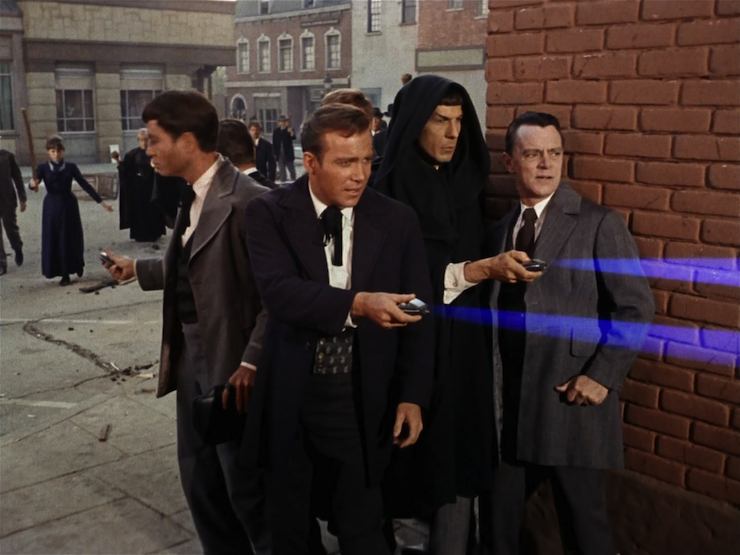
Reger takes him to a safe house where he has a lighting panel that is obviously way beyond the technology of this world. Reger claims it comes from the time before Landru. At Reger’s urging, McCoy sedates O’Neil before he can come around from the stun blast.
Several times, they have asked if the landing party are “Archons.” Reger finally explains that the Archons are people who came and resisted Landru, presumably the crew of the Archon. Spock has picked up powerful emissions, probably strong enough to bring a starship down from orbit, which may be what happened to the Archon. And, according to a report from Scotty, it’s happening to the Enterprise. Shields are up, but they require all ship’s power; if they divert power to the engines, the shields will fall and the ship will burn to a cinder. They’ve got twelve hours before they’re brought down the way the Archon was.
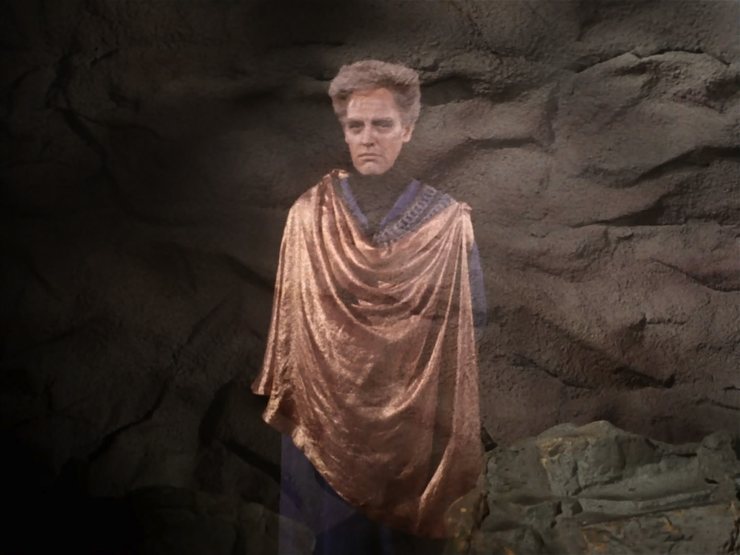
A hologram of Landru appears before the landing party, referring to them as a disease. Landru says this is a world without hate, fear, conflict, disease, or crime. The landing party, he says, will be absorbed and subverted into the common good of the body. And then they’re all rendered unconscious.
Kirk wakes up to find himself, along with Spock, Lindstrom, and Leslie in a cell. Their phasers and tricorders have been taken away. Two lawgivers come in with McCoy and Galloway, who have both been absorbed into the body, sounding just like Sulu did when he beamed up. The lawgivers take Kirk next, strapping him into a machine. The lawgivers are relieved by a man named Marplon, who turns out to be part of the same resistance as Reger and Tamar. When Kirk is released, he pretends to be of the body to fool the lawgivers.
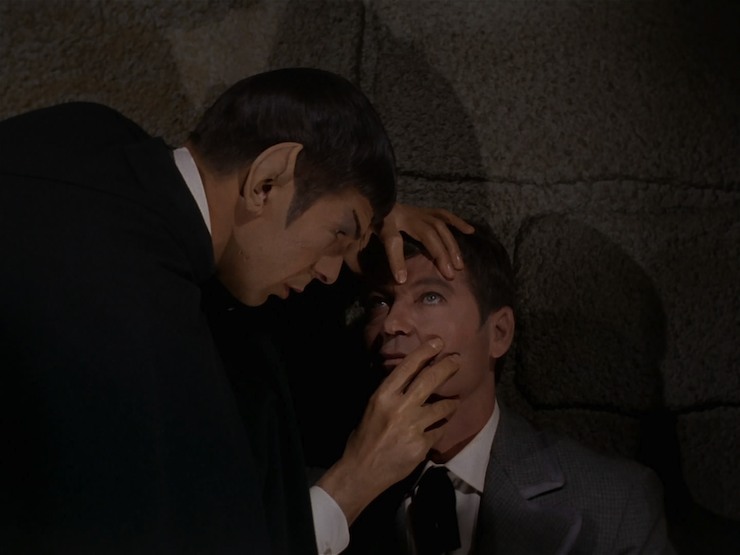
Spock tries to mind-meld with McCoy, but even he can’t get past the brainwashing. The lawgivers then take Spock away. Marplon reveals that he wasn’t able to help McCoy or Galloway, but he keeps Spock normal the way he did Kirk. Marplon gives him two phasers back and sends him away, with Spock, like Kirk, acting obedient for the sake of the lawgivers.
Back in the cell, Kirk, Spock, and Lindstrom speak in private while McCoy and Galloway sit beatifically (Leslie has, at this point, been completely forgotten about and is not seen for the rest of the episode). Spock believes that a computer is running the planet, a perfectly orderly society, but one with no soul, no spark of creativity. Kirk wants to pull the plug on Landru. Spock mentions the Prime Directive of noninterference, but Kirk dismisses that as applying to a living, breathing culture, not a stagnant one.
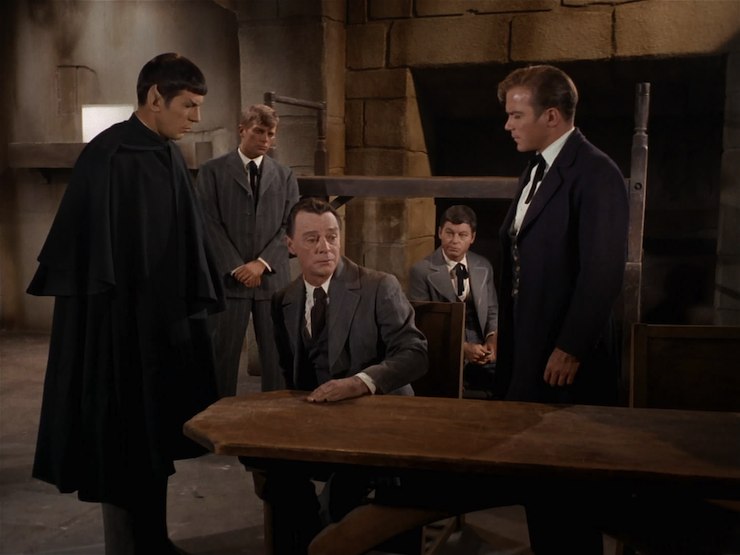
Marplon and Reger arrive, returning their communicators to them, but McCoy realizes that they’re not of the body and screams bloody murder. They manage to subdue him and Galloway, and then do likewise for the two lawgivers who respond to McCoy’s screaming.
Kirk and Spock put on the lawgivers’ robes and contact the ship. Scotty says they have six hours before their orbit decays. Kirk orders a guard placed on Sulu. Then they ask Marplon and Reger about Landru, whom they describe as a leader during a time of great war and bloodshed who saw the truth and changed the world, taking them back to a simpler time of peace and tranquility. They ask to be taken to Landru, but Reger panics and begs for the lawgivers to make him of the body again. Spock neck-pinches him, and then Marplon reluctantly agrees to take Kirk and Spock to the Hall of Audiences.
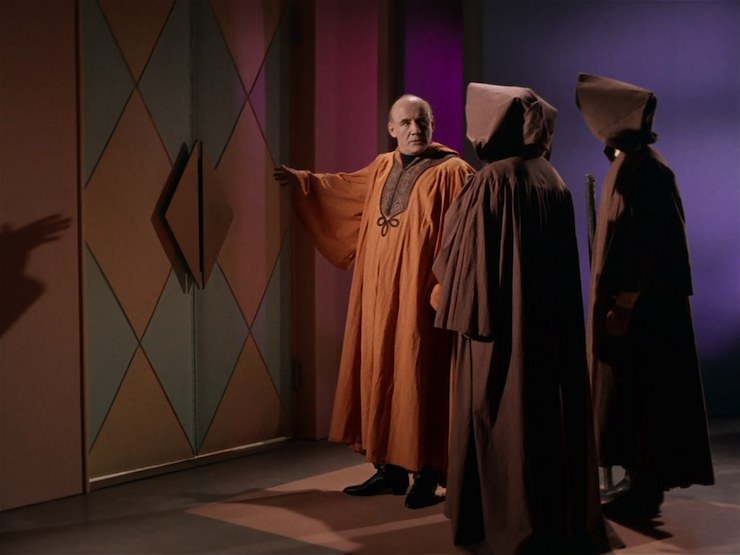
The Landru hologram declares that, for the good of the body, the landing party must die, as must everyone who saw them or spoke to them. Kirk and Spock fire on the wall where the hologram is projected, and find a room with a big computer in it. The computer calls itself Landru, and the original Landru likely programmed it. It neutralizes the two phasers. Landru insists that they will be obliterated for the good of the body.
Kirk asks Landru what is “the good”? Landru says peace, order, and tranquility are the good. Kirk and Spock convince the computer that without creativity, there is no life, and that by stifling creativity it is the evil that must be destroyed for the greater good. Done in by Kirk’s total bullshit, the computer smokes and explodes. The lawgivers find themselves without guidance, and Sulu is back to normal.
The Enterprise leaves Lindstrom and a team behind to help guide them back to normality. No idea who now controls things like infrastructure, food production, sewage, and so on…
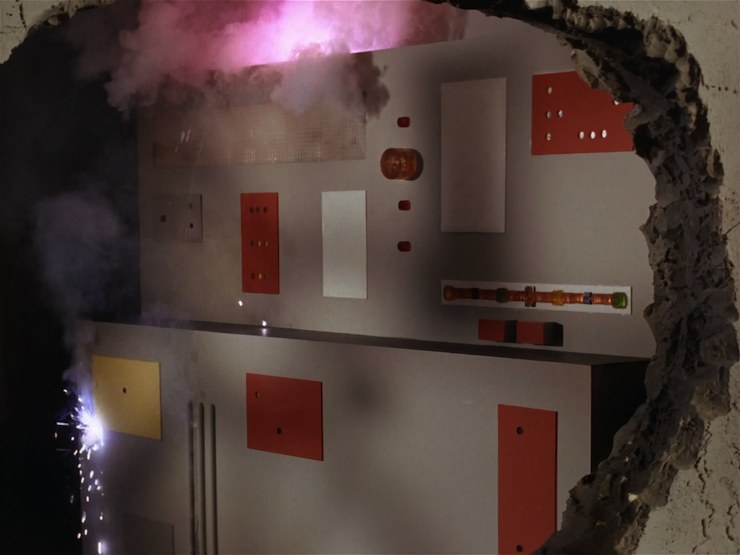
Can’t we just reverse the polarity? Apparently telling a computer that it’s evil is enough to give it an existential crisis. Who knew?
Fascinating. At one point, Spock decks one of the lawgivers. Kirk comments that that’s a bit old-fashioned and, perhaps conscious of that, he later gives Reger a nerve pinch like a civilized half-Vulcan…

I’m a doctor not an escalator. McCoy is actually pretty calm early on in the episode, which is probably so that it’ll be a bigger contrast when he goes bugnuts crazy later on…
Ahead warp one, aye. Sulu’s landing party is less than a howling success, since he can’t keep his cohort under control—although the time it takes the Enterprise to get their shit together and beam him out is what gets him brainwashed, since if they’d beamed him up when he contacted them, he’d have been okay.
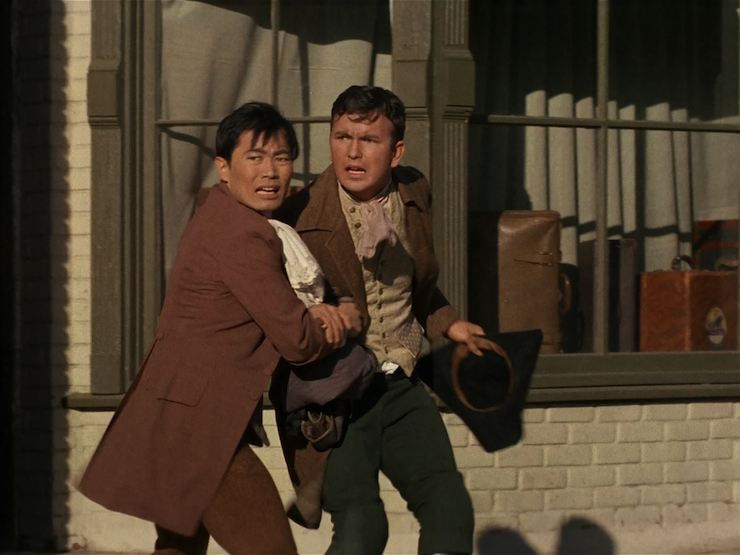
I cannot change the laws of physics! With Sulu out of commission, Scotty is left in charge of the ship, the first time we’ve seen the chief engineer as part of the chain of command.
Hailing frequencies open. Uhura doesn’t even get dialogue in the episode.
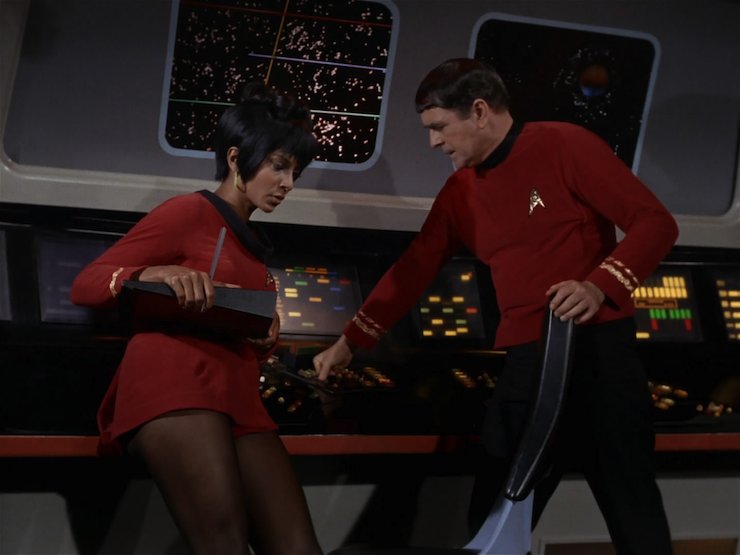
Go put on a red shirt. Galloway and Leslie—both guys we’ve seen before in various roles—are security and do absolutely nothing of any use whatsoever.
Channel open. “I prefer the concrete, the graspable, the provable.”
“You’d make a splendid computer, Mr. Spock.”
“That is very kind of you, Captain.”
Spock explaining his worldview, Kirk insulting him, and Spock refusing delivery on the insult.
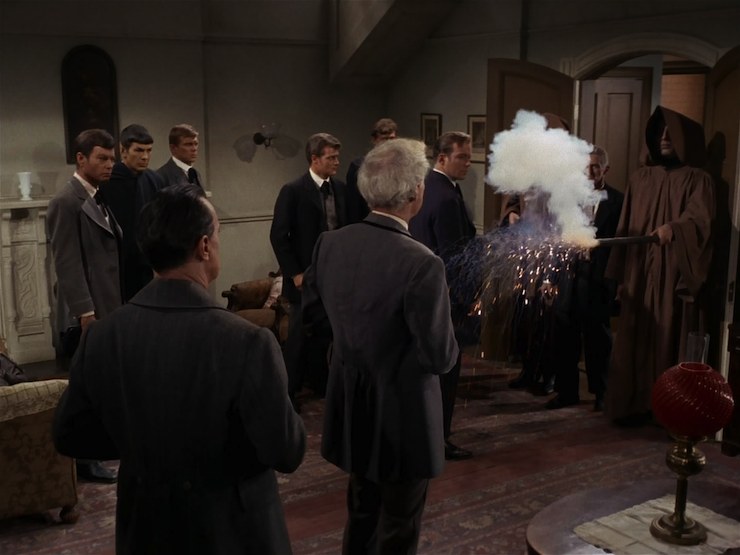
Welcome aboard. Lotsa guests in this one: Harry Townes as Reger, Torin Thatcher as Marplon, Brioni Farrell as Tula, Sid Haig as the first lawgiver, Charles Macaulay as the image of Landru (he’ll be back in “Wolf in the Fold” as Jaris), Morgan Farley as Hacom (he’ll return in “The Omega Glory” as a Yang scholar), Jon Lormer as Tamar (who previously played the image of a Columbia crewmember in “The Cage” and “The Menagerie,” and will return as the old man in “For the World is Hollow and I Have Touched the Sky”), and Ralph Maurer as Bilar (we’ll see him again as a Nazi in “Patterns of Force”).
And we have the various Enterprise crew, with the usual suspects DeForest Kelley, James Doohan, George Takei, and Nichelle Nichols, as well as David L. Ross and Eddie Paskey, plus Christopher Held as Lindstrom and Sean Morgan as O’Neill—Morgan will return as O’Neil in “The Tholian Web.”
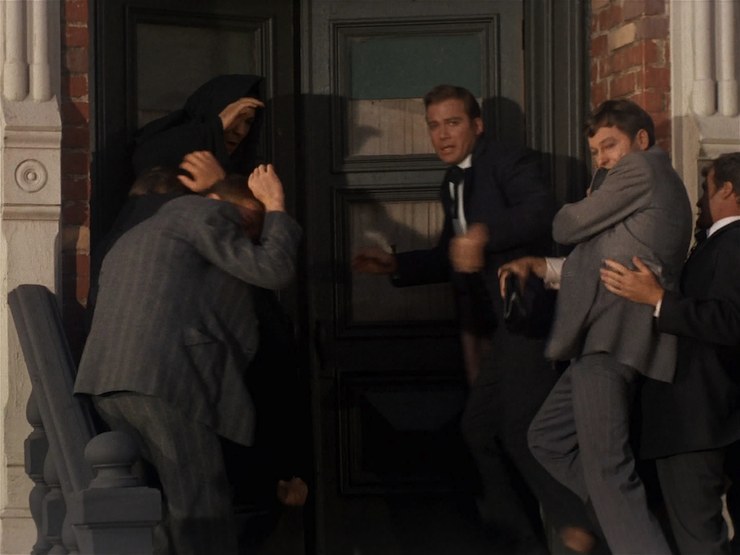
Trivial matters: Along with “Mudd’s Women” and “The Cage,” this was one of the three story outlines Gene Roddenberry originally came up with for the pilot.
The Starfleet Corps of Engineers series (edited by your humble rewatcher) did two different sequels to this episode. One was a direct sequel, as the Corps of Engineers ship the U.S.S. Lovell is sent to Beta III to deal with the aftermath of the Enterprise‘s actions (aided by Scotty) in Foundations Book 2 by Dayton Ward & Kevin Dilmore. And the Landru computer winds up affecting the Ferengi a century hence in Caveat Emptor by Ian Edginton & Mike Collins.
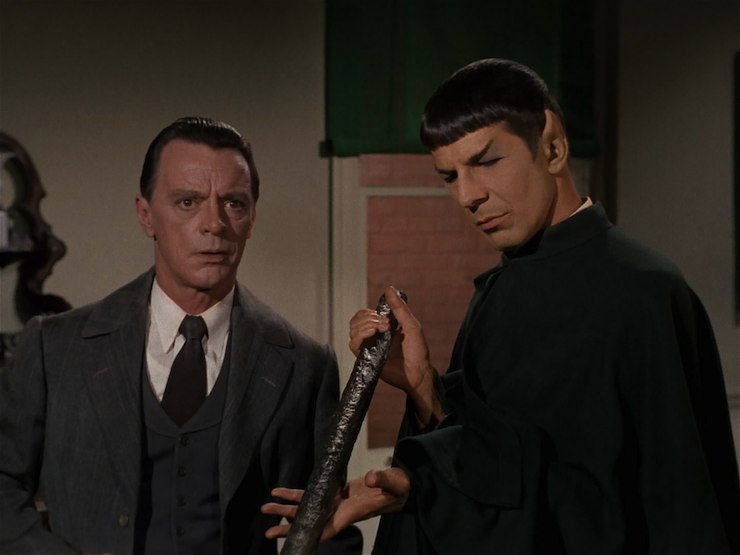
This story is told in the alternate timeline of 2009’s Star Trek and Star Trek Into Darkness in issues #9-10 of IDW’s Star Trek ongoing comic.
The U.S.S. Archon is seen in the Enterprise novel Kobayashi Maru by Andy Mangels & Michael A. Martin, and also in Martin’s Romulan War duology.
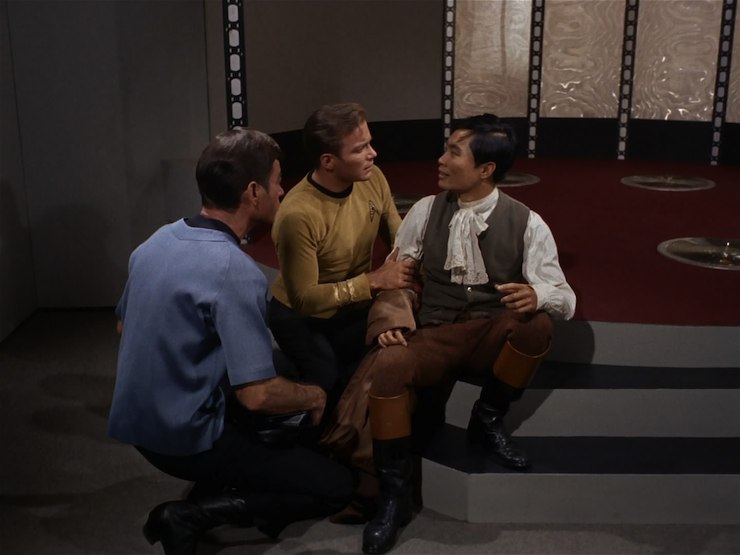
This episode has the first-ever mention of the Prime Directive, though it’s only mentioned long enough for Kirk to dismiss it as non-applicable here.
To boldly go. “Are you of the body?” What’s most frustrating about this dreadful episode is that it starts out promising. The teaser and Act 1 have some great stuff. There’s jumping right into the middle with Sulu and O’Neil being chased, then the intrigue of “red hour” and Hacom’s comment about how the landing party is too young to be excused from the festival.
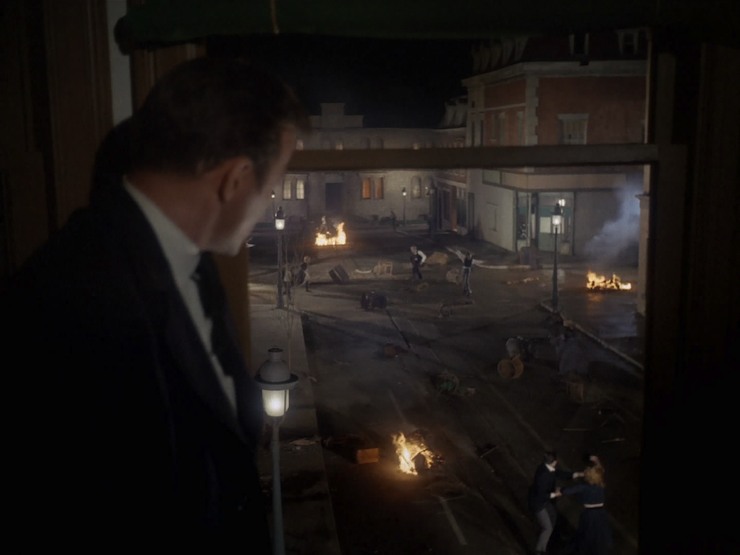
And then none of that is followed up on. The rest of the episode focuses entirely upon Landru’s orderly society. No mention is made of the festival after it’s over, nor is its purpose ever explicated. Nor does the script ever bother to explain why older people don’t participate in the festival.
Then we have the endless asking what Landru is without any kind of response, and constant repetition of stock phrases before we finally get to the climax, where Kirk convinces the computer that creativity is necessary for life, a specious argument that somehow makes Landru go tits-up in a puff of illogic. It’s the birth of two of Star Trek‘s most egregious clichés, the world-running computer and Kirk talking a computer to death, and while the former has potential (that the episode wastes), the latter is hilariously pathetic, as there is nothing in Kirk’s questioning of Landru that is in any way convincing as enough to make the computer go blooey.
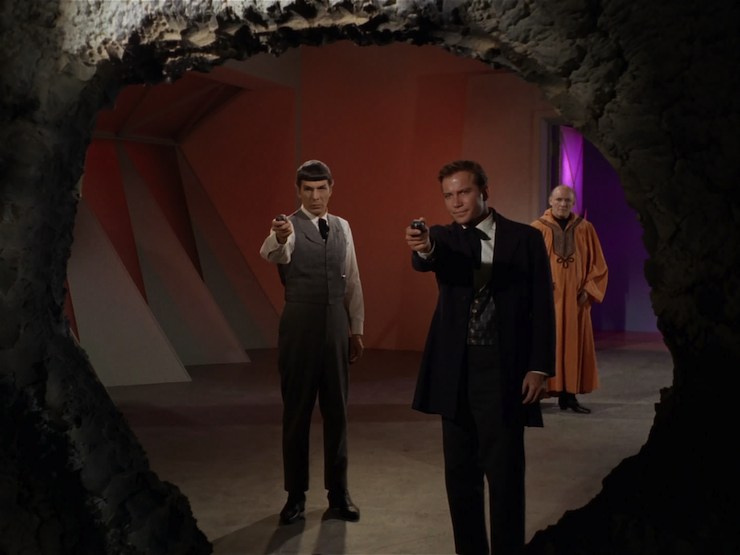
A good story could be made about a computer creating a society of rigid order and peace that has no soul, but this is so not it.
Warp factor rating: 2
Next week: “A Taste of Armageddon”
Keith R.A. DeCandido will be a Special Guest at the Myths and Legends Convention (a.k.a. MALcon) in Denver, Colorado this weekend, alongside Brian of Draco and the Malfoys, Stant Litore, Pandora Celtica, Tomas O’Dreams, Kilted Man, Quincy Allen, Vivian Trask, and bunches more. Keith’s schedule can be found here.










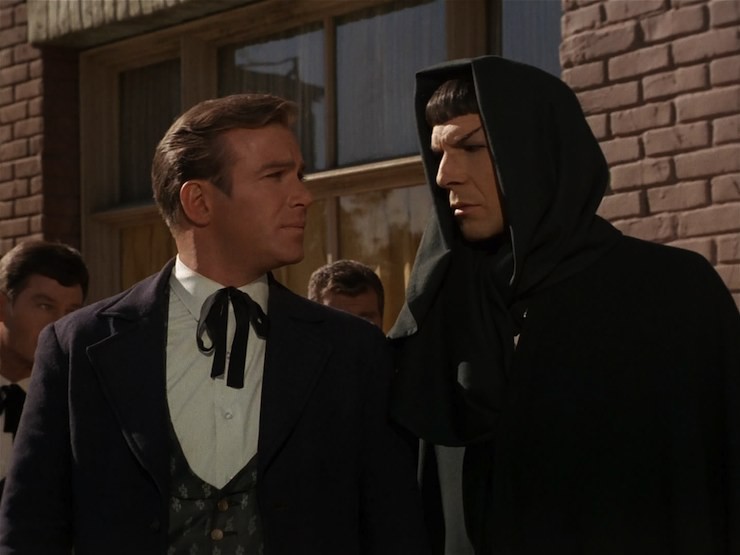
If I could make an addendum to “Can’t we just reverse the polarity?” it would be that this is one of only two times in all of Trek that we see the wide-beam setting on phasers. The other time is in “Cathexis” from Voyager. It seems a bit odd that it wouldn’t have come up at least a few more times…
I absolutely love De Kelley’s performance in this, once he’s of the body. His demeanor, facial expressions, and outfit all work perfectly together. Phenomenal stuff.
Could be wrong, but I’m pretty sure this episode inspired those Purge movies from the past few years. I haven’t watched them, so can anyone say if they’re better than Archons? I certainly hope so. This one is a mess.
I frequently tell my computer it’s evil, but it’s never blown up. I’ve blown up at it, though…
Another Trivial Matter: Lindstrom is a major guest character in my first Trek novel, Ex Machina.
Are you sure about that factoid that the early version of this episode (under the title “The Perfect World”) was a candidate outline for the first pilot? As far as I can tell, that claim comes from the notoriously badly researched These Are the Voyages by Marc Cushman, and it sounds like a misremembering of the fact that “Where No Man Has Gone Before,” “Mudd’s Women,” and “The Omega Glory” were all written as candidate scripts for the second pilot, conflated with the fact that “The Perfect World” and “The Women” were two of the multiple single-paragraph story seeds from the original 1964 series pitch document. Maybe Cushman had sources I’m not aware of, but from all I’ve heard about his books, I’m leery of any claims they make that aren’t corroborated elsewhere.
Well, this episode has all sorts of problems. One of the main ones for me is that it’s an Earth-parallel culture without any justification for being one, a lot like “Miri.” Sure, the planet doesn’t actually look like Earth, but its clocks have 12-hour faces in Arabic numerals, the outdated clothes Lindstrom picked based on the century-old Archon reports were from the colonial/18th-century rack of the Desilu wardrobe department, and the present-day Betan clothes were from the 19th-century rack. The one thing that makes sense about IDW’s Abramsverse retake on this episode — which ignores the entire divergent-timeline premise of the Abramsverse and contradicts the established history from this episode, claiming that Landru was a Starfleet scientist who’d been a member of the Archon‘s crew — is that it justifies the Earthlike elements of the planet’s civilization. (I came up with my own handwave in Ex Machina, but it was a real stretch.)
It’s also an enormous coincidence that our heroes so quickly stumble upon two of the only people on the planet who can resist Landru’s brainwashing. And how come Sulu was instantly converted by the Lawgiver’s staff, but the others needed to be put in a brainwash-o-matic machine?
As for the Festival, I’ve always figured it was, like pon farr, the price paid for the control imposed on the people the rest of the time. A way of releasing built-up tensions before clamping down on them again. But apparently that was never established onscreen, so I don’t know where the idea came from.
I could have sworn there was dialog to explain the red hour/festival as a necessary outlet after a year of total repression. Also, how lucky the Enterprise picked that one day to show up.
@3/Christopher – In the novelization for this episode, Blish claimed it was a form of population balance. They’re all going to get it on during the good times, so there’s lots of babies; then you have to have them slug it out and kill each other so there’s zero population growth.
(Side note – nice to have met you at Shore Leave!)
@5, that’s kind of stupid/horrible. Why would not marital relations be encouraged by the body? As necessary to the health and growth of the body (Like the RC church views on the subject.) And since Reger’s daughter is pretty clearly raped (as far as 1966 could go in that direction), then Blish’s interpretation is that Landru’s goal was a society founded on rape and murder. Far better for festival to be something the computer came up with ad hoc once it was clear that forced obedience was causing crack-ups in the population in the first years/decades after Landru set things up.
If anyone can talk a computer to death, It’s William Shatner :)
On a more serious note, this was written at a time when computers and their limitations were not widely known. It’s not too far a stretch, given the line of thinking which led to Asimov’s laws of robotics,
That said, I have difficulty arguing with the rating of the episode.
My problem with this episode, including the Kirk talking the computer to death bit, is that Starfleet has waited 100 years to go looking for a lost starship. Either Starfleet is horribly overtasked with hundreds or thousands of other duites, or they just don’t give a damn about ships and crews. This isn’t the only episode where they go looking for lost ships after decades or more; Bread and Circuses and A Piece of the Action come to mind.
Using historical western clothing is a visual clue, without requiring much exposition, that Sulu’s party is dressed inappropriately but that the native culture is also well behind contemporary culture. So it does not seem to me something to worry too much about.
On the other hand, it does bring a fridge logic problem to the episode resolution. If Landru’s great evil is that it has stifled humanoid creativity, why has there been a noticable change in clothing fashions? Fashion is a result of creativity and cultural churn. A stagnant society would still be wraring the same clothing styles as it did a century ago.
Thus we get to see Trek’s funniest cliché being born.
I get into heated arguments with my laptop every single day. I get into even worse arguments with my home’s tenuous internet connection. They never listen to my complaints of poor performance!
Seriously, the episode is horrendous, but I absolutely adore the cliché for what it is. It’s too bad Twitter didn’t exist in 1967. Imagine the memes that would have sprung from this episode alone.
And ironically, this turned out to be one of Roddenberry’s pilots, something I didn’t actually know until now. Between this and Mudd’s Women, I’m sure Gene wrote The Cage clearly aware it was going to be the real one. I guess it gave him freedom to half-ass the development process for the other ones. I’m actually currently developing two potential shows (including full bibles), but I definitely see one as having way more potential than the other.
@8 makes a very good point. Why did Starfleet wait 100 years to find this ship? Were they looking for it for that long or just shelved the mission until they felt like it? This brings up the point of where is this planet located. After all, the ship disappeared right around Archer’s time, with the NX-01 still in active duty. Back then, ships couldn’t even reach warp 5. So the U.S.S. Archon couldn’t have traveled THAT far.
And of course, we never get a decent rationale for Kirk’s unilateral decision as he alters the course of an entire culture without regard for consequences. I’m actually curious as to Keith’s take on this matter when we get around to rewatching next week’s A Taste of Armageddon, which to me commits the same sin, by having Kirk alter yet another alien culture without anyone questioning his decision.
And let’s not even get into the whole Earth-parallel culture situation. At least the Rick Berman-era shows tried to differentiate alien worlds.
I’ve said it before, I’ll say it again: surprisingly inconsistent first season in retrospect. From Arena to Alternative Factor; from Tomorrow is Yesterday to this.
Overall impressions: Some problems here and there (Kirk talking the computer to death, hand-waving the prime directive, etc) , but there’s also a lot of good stuff.
My rating: 7
Various random observations:
Favorite bit: Gotta be the Red Hour.The transition from eerie calm to sheer pandemonium is quite disturbing
Worst bit: Talking the computer to death.Frankly, the only time that this ever really worked was in “The Ultimate Computer,” where the eponymous machine’s thinking processes were based on those of a mentally unstable individual
Earth-style clothing: It doesn’t really bother me that much, particularly when you bear in mind just how unattractive ST’s attempts at alien attire could be (cf next week’s “A Taste of Armageddon”….).
@3 Christopher L Bennett:
Yeah, that’s always been my impression regarding the Red Hour.It’s a Dionysian outlet in otherwise Apollonian society.It’s never spelled out, but that’s the way that it “reads” onscreen.
@2 George Kaplan:”Could be wrong, but I’m pretty sure this episode inspired those Purge movies from the past few years.”
That seems to be the case.Here’s a comment from The Purge’s writer/director:
“When asked if Return of the Archons was in fact an inspiration for The Purge, writer/director James DeMonaco smiled and told me, “That’s what my dad brought up when I told him the idea. My dad forced me to watch [the originalStar Trek] over and over.””
via Birth.Movies.Death.
@9 Crusader75:”On the other hand, it does bring a fridge logic problem to the episode resolution. If Landru’s great evil is that it has stifled humanoid creativity, why has there been a noticable change in clothing fashions? Fashion is a result of creativity and cultural churn. A stagnant society would still be wraring the same clothing styles as it did a century ago.”
Could be a form of limited, allowable creativity.Things like technology are kept locked in place, but the people are allowed to alter their fashions to a limited extent.
Answering these in order of subject matter rather than numerically:
@8/Ragnarredbeard: You need to keep something in mind that was largely ignored by later Trek productions: That the galaxy is huge and the distances between star systems are enormous. Not to mention that the sheer number of stars in the galaxy is mindbogglingly immense. At a rough estimate, there are maybe 15,000 star systems within 100 light-years of Earth. If you visited a new one every week, it’d take nearly 300 years just to visit every one of them once, never mind how long it’d take to explore them thoroughly, colonize them, open diplomatic relations with them, or whatever. So since we’re talking about a deep-space ship lost in a distant star system, it’s not that implausible that it would’ve taken a century to return to that system to search for it. Space is more than vast enough to strain the resources of even a large multispecies civilization.
@10/Eduardo: A hundred years before the episode would’ve been 2167, more than a decade after Enterprise‘s fourth season. Ships capable of warp 5 and above were definitely around then. Not to mention that Enterprise itself traveled well beyond the territory that’s well-explored by the Federation in later centuries — just as Ferdinand Magellan sailed past territories that other Europeans would not explore in depth for centuries to come. Exploration is not a perfectly symmetrical expanding sphere. Again, there are tens of thousands of star systems very close to home, so if you sail straight out past them, you’re still leaving a huge, huge volume of uncharted space behind you, and it’ll take an awfully long time for other ships to fill in those gaps.
@9/crusader75: Indeed, the incongruity of the stagnant culture having changing fashions is one of the things that just doesn’t work about the bit. As with other aspects, there are ideas in the former part of the episode that seem forgotten in the latter part.
@13/trajan23: I think that “limited, allowable creativity” explanation is what I went for in Ex Machina. Landru recognized that the people needed some variations in their lives, but it had no creativity and could only recycle historical fashions. Then the Archon came along and gave Landru a source of historical Earth fashions (both sartorial and architectural) to draw on.
My guess is a communications problem rather than a problem with being willing to send a rescue ship. Whatever happened, no one knew exactly where the Archon went down until recently.
@14: The Archon incident takes place six years after These Are The Voyages, to be exact (which took place in 2161). But you make a good point. Exploration isn’t about travelling in a linear direction, and there were probably more warp 5 capable craft by then.
The Magellan analogy is a good one, having traveled past Argentina and Chile into the Pacific in a few years, while everyone else focused on exploring South America’s natural resources, taking decades or more to cover ground.
Tough crowd here. I know it’s a flawed episode, but it was entertaining.
I don’t read every Star Trek book that comes out (way too many) but it would have been fun to see a novel-length version of this, dealing with the Red Hour and the resistance and everything.
Except Kirk’s illogic-ing the computer to death. They could have skipped that or made a better ending.
@16/Eduardo: But that would require counting “These Are the Voyages,” and nobody wants that.
I always thought that one was a bit weak, but it works better than this episode’s. The best one, though, is clearly ‘The Changeling’, in which Kirk confronts Nomad with its own relentless logic and causes it to sterilise itself.
My favorite talk-the-computer-to-death episode was “I, Mudd.” Screw using syllogisms and weird logic, just be totally batshit crazy….
—Keith R.A. DeCandido
I think “talking the computer to death” is part of a bigger problem which is “talking to the computer”. There are many episodes where they use everyday language to address the computer and it understands perfectly what they want, which is in general something we still cannot do today. Although, has anyone tried talking Siri to death? Maybe William Shattner should take a shot…
@7 That fear or misunderstanding of potential of computers was very much a part of 1960s culture The idea of “master computer taking over the world” was prevalent in SF during this period: “I Have No Mouth and I Must Scream” was published in 1967, “Jamboree” by Jack Williamson came out in 1969, and Arthur C. Clarke’s “Dial F for Frankenstein” around 1965.
Kirk convincing a computer to blow itself up is one of my favorite of the original series clichés, ever since I first saw it in “The Changeling.” (Though, at first, I was a little disappointed that the episode had nothing to do with DS9’s shape-shifters.) So I was bummed at what a lackluster start the cliché got with this episode.
-Andy
A lot of layers to discuss here; forgive me if my thoughts are a little scattered. Just hoping to take the conversation down some different thought-paths.
Through the lens of Asimov, if one allows that the computer is a type of robot: Landru has obviously violated the first law, but obeys the second by ignoring the third. Self-preservation is subordinate to obeying humans, and Kirk says blow yourself up, so…boom.
Of course, to achieve sufficient sentience to blow yourself up, you can end up with The Matrix level AI. Computers essentially were humans in the Matrix; they had the ability to reproduce, reprogram, etc. What if Landru is at that same level, basically human-like, but has a line or two of obeying humans left? Of course, he doesn’t quite pass the Turing Test, because they figure out he’s a projection and a computer. But still – can Landru be equated to the AI level in the Matrix?
And what about Data? In “Eye of the Beholder” Data says he considered a hard reset, shutting himself down. He and Geordi talk about committing suicide – is a computer being convinced to kill itself so much harder to accept than a computer that wants to commit suicide?
Again, not trying to provide answers, just theories to bandy about…
Clichés aside, I always felt Trek had the potential to do a real emotional take on the death of artificial lifeforms. Had Data not died by the Scimitar’s explosion on Nemesis, I could have pictured the situation. They could have even used a TNG film to do so (had Nemesis not been a box-office failure, obviously).
Having an android or computer shut down could be a poignant event. I can recall sad events such as Roy Batty’s death on Blade Runner, HAL’s demise on 2001, or the Aprilbot’s emotional shutting down on Buffy the Vampire Slayer. I could have seen Data meeting that quiet, prolonged fate. Hell, even Nemesis has a fleeting glimpse of the process when Data briefly shuts down B4.
And it’s not as if Trek hasn’t tried to do similar stories such as the holographic cop’s vanishing on TNG’s Big Goodbye. The potential is clearly there.
I’ve got no problem with talking the Landru computer into shutting down, although the time frame is compressed and unrealistic. Assuming that this is an AI that learns and grows (and not just a “computer”) and was programmed with the original Landru’s goals for society, I would ask it whether the original Landru really intended to create a totalitarian state with no free will, half the population under direct mind control, and annual orgies of rape, looting and murder to relieve the pressure. I’d guess that those things were “evolved” by the Landru AI as means to maintain the peaceful society, but were not really part of the original Landru’s original plan*. I think the AI could be reminded of its original goals and talked into realizing that it was completely stifling society against Landru’s original plan. It would take longer than 3 minutes, and would require some sociology perspective from other planets and societies (hey look, the Vulcans are peaceful without mind control or rape and murder), plus forcing the AI to look at it’s original program and how society looked on day 1 of the program, not just what it evolved to be. But I think it would be doable.
*(Really, who tells his people, “I’m going to get end war by destroying all the technology and taking us back to a simpler existence, but the price will be total mind control with occasional outbreaks of unpunished rape and murder.”)
@24/MeredithP: I think the idea back then was rather the opposite of what you’re suggesting: that computers were so simple and limited that they couldn’t handle anything that contradicted their programming or defied their ability to process. It’s worth keeping in mind that computers at the time were based on vacuum tubes — and most SF writers assumed they always would be, even millions of years in the future. Vacuum tubes run pretty hot, need a lot of cooling, and can burn out relatively easily. So at the time TOS was written, the assumption may have been that if a computer were given a problem that its programming couldn’t resolve, it’d get into a processing loop, overheat from the heightened activity, and blow out its tubes. It seems nonsensical to us today, but that’s because we’re used to computers whose solid-state hardware is more reliable. If a modern computer gets caught in a loop, you can just hit control-alt-delete and End Process. But to ’60s audiences, the idea of a computer overheating and burning out when forced to work too hard would’ve been far more plausible. And computer programs would’ve been so much simpler that the idea of a computer being unable to parse a simple paradox would’ve been more plausible too.
Still, I agree that in this particular case, it wasn’t well-handled. Even if you assume that the computer is simple enough that it blindly tries to process any data put into it (even “You are the evil and evil must be destroyed”), the question arises, why did nobody try that before? Okay, they never blew out the wall and faced the computer directly, but it could monitor everything they said and did. Surely it would’ve heard those ideas expressed by resistance members before. So why didn’t it blow itself out long before Kirk got there, if it was so easily overwhelmed by the first hint of an existential crisis?
@22 Pretty much the conclusion I was trying to get to. Thanks for that. Original Trek was very much a product of its time, which is why so many episodes feel like they should be narrated by Rod Serling.
Those ideas haven’t gone away. You can look at The Matrix and the Terminator franchises for more recent treatments of the idea.
@27/Christopher: But did the resistance movement know that Landru was a computer? Did they even know that computers exist? I thought this was what they mainly needed the Enterprise crew for – to show them the true nature of their “government”.
All the flaws of this episode have been pretty well covered, so I’ll just share that I’ve always thought Reger bears a passing resemblance to Jeremy Brett as Sherlock Holmes; and that Landru’s sideways hairstyle reminds me of Samuel L. Jackson as Mr. Glass in Unbreakable. Nothing deep, but, then again, there’s not much depth in the episode, either.
@29/Jana: They didn’t need to know Landru was a computer, because I’m talking about what Landru knew and heard. In the climactic scene, all Kirk had to do to destroy Landru was to say “You are the evil, you are hurting the society you want to protect.” My point is that, given that Landru was presumably monitoring everyone and everything that happened on Beta III, perceiving it through the Lawgivers’ eyes and ears and probably through other means, then Landru should’ve heard many people expressing those ideas in the past — say, any time the Lawgivers came to kill or reprogram someone for their defiance and they spoke up in protest about how “the Body” was harming society. I just can’t believe that Landru spent 6000 years oppressing people and neutralizing dissenters without ever hearing anyone express the notion that its methods were less than beneficial. If simply exposing it to that idea was enough to blow it up, then it should’ve blown itself up long ago.
@27/Christopher – Hmm, okay, fair point on the actual physical burnout being part of it back then. Although wasn’t that the theory behind the topological anomaly virus Hugh was to introduce in “I, Borg” too? That the Borg would get so hung up on the unsolvable thing that they’d shut down?
I just realized “Return of the Archons” bears some similarities to a Twilight Zone episode called “The Old Man in the Cave.” The all powerful computer was on a lot of minds in the ’60s, I guess.
By the way, has Tor.com ever done a TZ retrospective? If not, maybe after Trek…?
Few other general observations/comments:
Ancient Artefact: I really liked the light-panel prop. Surrounded by what was essentially Victorian tech, it looked genuinely alien and super-sophisticated.
Mind-controlled mob: Already commented on the eeriness of Red Hour (utter tranquility to total insanity in a split-second), but the scene where the Body is ordered to attack the the landing crew is like something out of a silent horror movie.Very effective.
Maybe too much going on?: I think that part of the problem with this episode is that it has almost too much going on. The fate of The Archon. Rescuing the mind-controlled O’Neil.The mystery of Red Hour. Confronting Landru. The Resistance to the Body, etc.There’s enough here for a two-part episode, really.cramming it all into one episode means that a lot of it remains undeveloped.
@32/MeredithP: Sure, the principle in “I, Borg” was similar, but more sophisticated. Even modern computers can freeze up and crash if they get caught in a processing loop of some kind, but it has to be more complex than the simple paradoxes that did the job in TOS.
@CLB
“And how come Sulu was instantly converted by the Lawgiver’s staff, but the others needed to be put in a brainwash-o-matic machine?”
YEP!
@31/Christopher: OK, now I get your point.
But I can easily imagine that Landru processes information differently depending on the input channel – maybe only information given it directly is treated as fact and reaches his “reasoning” subroutines. Or circuits. Or whatever.
Anyway, as others have already written, it’s a lame talk-the-computer-to-death scene. It works much better in “The Changeling” and “The Ultimate Computer”.
@37: Although it still makes more sense here than in Logan’s Run.
Did I miss something, or was it just another hole in the plot: If Marplon cannot be absorbed, this can only be known if the Lawgivers tried to absorb him and failed, so Landru would also know. Why would Landru allow Marplon to continue to live, let alone operate an underground resistance? Killing isn’t beneath Landru when it’s necessary (as he told Kirk and Spock because of their repeated resistance) so why didn’t Landru just order the Lawgivers to kill him?
Yeah, this one draws you in quite nicely in the teaser and first act, but then the script just shrugs its shoulders and wings it for the rest of the episode. Another episode I watch to get to the next one, which is one of my favorites.
Oh yeah, and I just remembered Uhura’s one bit of dialogue is at the end, and it’s off-camera, when she says Lindstrom was calling from the surface.
Folks, I’m at a convention in Denver and not coming home until late Monday night, so in the interests of what passes for my sanity, the rewatch of “A Taste of Armageddon” will happen on Wednesday.
—Keith R.A. DeCandido
@1/MeredithP: We see the wide beam phaser setting toward the end of “A Piece of the Action” where having everyone in the street knocked out finally convinces the mafia types that the Federation has the power Kirk has been talking about.
@11 – trajan23: Trek’s alien clothing is horrible, but nothing beats TNG/DS9/VOY human civilian clothe. Ugh.
@7 – Chris: I always find it funny that scifi writers of the past assumed that computers would always, forever an ever, be constructed of vacuum tubes and run with tapes, etc. I mean, didn’t they see the difference between houses, cars, airplanes from five decades before? You’re writing a scifi story in 1966, and you can’t realize that the car you drive is very different than the one someone tested in 1895? Or that the airplanes you use to fly from one end of the country to the other bears little resemblnce to the airplanes used in WWI? I know WE as writers will probably look ridiculous to people in the future, but still… a little imagination, that’s one of the requirements for fiction writing!
@43/lordmagnusen: But those older and newer cars both used internal combustion engines and wheels, and those older and newer planes both had wings. It’s easier to imagine an incremental advance than a totally new technology. Those future computers use much smaller, more reliable vacuum tubes! Their tapes can hold far more information! And of course the circuits that incorporate those tubes and the programs that run on those tapes are far, far more sophisticated and intelligent.
And of course, alongside the retention of technologies that they didn’t know would become obsolete, those writers predicted lots of innovations that never happened, like disintegrator rays, antigravity, food pills, force fields, and the like. The imagination has always been there; it just doesn’t line up well with the real future.
On the subject of “horrible” clothing, I still say that it’s unrealistic for fashions of the future not to look bizarre and ugly by our standards. Just look at 1970s fashions, or 1770s fashions, and consider how bizarre and hideous they seem to us. If anything, Trek was way too conservative with its future fashions.
@24 – Landru apparently built his computer intentionally as a Zeroth Law AI, individual humanoid needs have less priority than the needs of the species (as the AI understands it) so it can ignore any First Law imperatives at will and makes the 2nd Law something that never crosses its motherboard (in fact it completely inverts it).
The Zeroth Law always left me cold as a concept because of those implications.
Chris, I’m with you on the computers, we never get stuff quite right, and it’s easy to judge 60s writers with today’s knowledge… still… that particular part was never their forté.
As for TNG era civilian clothing… it’s not that they weren’t bold enough (they weren’t), it’s that it all looks like silly 90s crap. :) Too silly.
@CLB: “And of course the circuits that incorporate those tubes and the programs that run on those tapes are far, far more sophisticated and intelligent.”
Perhaps, but even the Enterprise’s computer wasn’t sophisticated enough to prevent it from being tricked into attempting to calculate pi to the last digit, in “Wolf In the Fold.”
I think this is what my hacker friends would call an “exploit.” You’d think that at some point, some adversary of Starfleet’s would have hit on the idea to try to get Starfleet’s computers to blow themselves up…
@47/Lance Sibley: Ah, but it was Spock who gave the computer that order, and he prefaced it by saying, “Computer, this is a Class A compulsory directive.” So it wasn’t something just anyone could order the computer to do. Spock, as the first officer and science officer, had what I suppose we’d call administrative access to the computer, and was thus able to give it instructions that it wouldn’t accept from anyone but an admin, root-level commands that would override all other processes.
@42/aloysius – That’s from the ship, though. I meant hand phasers.
@44/Christopher – Funny you say that, I have always loved Bill Theiss’s designs!
@49/MeredithP: But that’s my point — if we saw actual fashions from 2-300 years in the future, we probably wouldn’t like them at all. We’d find them bizarre and ridiculous, like the way we look back at powdered wigs and enormous bustled dresses. So if a show set centuries in the future has fashions that are appealing to our present-day aesthetics, that’s probably very unrealistic.
@49/MeredithP: In “Elaan of Troyius” Spock knocks out two of Elaan’s hench-guys with a single phaser shot, just as they’re about to attack Kirk at the door of her quarters. Does that count?
@50/Christopher – Ah, gotcha. Thank you for clarifying for me.
@51/aloysius – I’m just talking about the stated use of “wide beam” on the personal phasers. There’s only two stated uses.
@50/Christopher: But isn’t it mostly the early modern age that looks silly to us? A lot of people like ancient Greek dresses and Celtic, Germanic or medieval clothing. Roman haircut for males looks quite contemporary. So maybe we would like future fashion, and maybe we wouldn’t.
@3 CLB Maybe it’s been covered before, but despite dialogue in Trek 2009 regarding the divergence if the timelines, I think it’s apparent from the production design—and even casting choices—that the Abramsverse was separate from the “Prime” universe long before Spock Prime and Nero emerged from the wormhole created by the Hobus disaster. So it’s possible in the Abramsverse that Landru was an Archon.
Regarding fashion, yes there is no good reason for fashions to have changed on Beta III, other than to make the Enterprise crew obviously out of place. And I agree that it was a mistake for all civilian clothes in the sequel series to be shimmery as if they were synthetic (though I also think this is more our perception than reality), I don’t think they are impractical per se. In fact, it seems like we’re trending toward more practical (i.e., functional and comfortable) clothing in general—saggy jeans, notwithstanding. I would argue that everyday fashion hasn’t changed really much in the past 40-50 years, maybe earlier. Most folks in the U.S. wear denim pants and cotton-poly tees or collared shirts. The clothes in the TNG era seem, more than anything, comfortable. And why wouldn’t they be, given that the Enterprise-D is basically designed like a big hotel?
@54/rowanblaze: Difference in production design is a matter of artistic interpretation, not underlying reality. The production design of TMP and the later movies is totally dissimilar to that of TOS, but we still accept them as the same reality — even though there were people at the time who used it as an excuse to insist they were separate universes. Of course different artists are going to interpret the same subject differently, but it doesn’t make sense to confuse that with a diegetic difference. John Romita’s Peter Parker looked different from Steve Ditko’s, but that doesn’t mean he got plastic surgery. It just means that the same face was being interpreted by a different hand and eye.
After all, if the Abramsverse hadn’t been meant to be a connected reality, then the screenwriters would never have bothered to include all that convoluted time-travel stuff and coax Leonard Nimoy out of retirement. None of that served a story purpose except to establish that it was a branch off the original history, a direct continuation of the life of the same Spock we’ve been following since 1966. I’m bewildered that so many people don’t realize that.
Of course, the writer of the comics, Mike Johnson, pretty clearly does believe that the Abramsverse is just one of an infinity of pre-existing alternate realities, since he’s done a number of stories based on that premise. But that’s just one of several ways in which I’ve found Johnson’s interpretations to diverge from what the screenwriters most likely intended. (Like how, in the prequel comic to STID, he took the throwaway line about the scout ship impounded in “the Mudd incident” and presented the “Mudd” in question as a sexy young half-Bajoran woman. Huh?)
What if one looks at this episode as a critique of blind religion? Landru’s henchmen wear robes reminiscent of monks. The people are subjugated by an omnipresent powerful deluding computer generated being, vacillating between complacent empty souls to animal instinct hedonistic humans. Without Landru, humans are without bounds or able to enjoy carnal pleasures or kill each other.
Repeatedly we hear of blessed be the body. If not of the body (of Christ) then one is forsaken. And though it is controlled by a machine, the people operate by orders, much like religion.
The enterprise and the landing party represent the rational balance brought on by science based society. Even the brainwashing operator seeks the promised ones who will free them of the tyranny of Landru (religion).
This is clearly a violation of the prime directive, which would not differentiate between a stagnant culture and one that is growing.
At the end of the episode he notion that freedom mean responsibility contradicts the idea of religious based predestination. Much like western religion, Landru is a prescribed life. With freedom, there is no code of rules except those created by free humans.
How to explain the lack of soul in Landru? When pressed, Landru is accused of destroying the body without freedom of choice. How is this different from much of religion that seeks no freedom of choice but blind obedience? That the “evil” must be destroyed and the subsequent destruction of Landru represents more religious references and the expulsion of the people from the garden of eden.
@56/Jim: “This is clearly a violation of the prime directive, which would not differentiate between a stagnant culture and one that is growing.”
That’s back-projecting TNG-era assumptions onto TOS. Remember, this is the episode that introduced the concept of the Prime Directive in the first place, and as Keith mentions in the recap, Kirk explicitly says that it “applies to a living, growing culture,” as opposed to one forced into artificial stagnation. He makes a similar argument in “The Apple,” saying the inhabitants deserve the freedom to make their own choices rather than having their lives controlled. So as TOS’s writers intended it, the Directive was not so much an anti-interference policy per se as a pro-choice policy. It was about ensuring that other civilizations had the right to make their own free choices rather than having decisions imposed on them by some external force, whether that imposition came from Klingon infiltrators, rogue Federation captains or professors, or false computer gods. It meant that the Federation couldn’t tell another culture how to live, but it could stop someone else from telling them how to live.
By the TNG era, that kind of activism had come to be seen as just another layer of cultural imperialism, still making others’ decisions for them however benevolent the intent, so a more rigid hands-off policy had been adopted. But it’s important to understand that the TOS-era Prime Directive was different.
Somehow I managed to never see this episode despite watching Star Trek for nearly four decades. Also, this might be the worst episode of Trek I’ve ever seen. At least as awful as TNG’s pointless stinkers like The Last Oupost or Night Terrors.
@58/Steve C.: “Night Terrors” is about the hazards of communication with aliens and has some cool surreal imagery. I don’t find that pointless.
@59/JanaJansen Actually you’re right. I was thinking of “Man of the People,” and was getting my somewhat bizarre Troi episodes confused. Now that I think of it, The Last Outpost is a prettygood comparator for “Archons,” as it is an early TNG episode that starts out with some promise, and then goes absolutely nowhere, and takes a long time doing so. Also, if memory serves, Riker basically talks his way out of being destroyed by a computer as well.
@60/Steve C.: In this case, I agree. “Man of the People” is so nondescript that I keep forgetting that it even exists.
In “The Last Outpost”, Riker saves the day by quoting Sun Tzu. I liked that when TNG was new – I liked that he quoted a Chinese philosopher instead of someone from Europe – but really, it’s just as simplistic as Kirk convincing Landru to self-destruct in a mere three minutes.
If I remember my history correctly, archon* is the term for demon in some gnostic belief systems. In RoA, the Computer-Landru perceived the crew of the Archon as demons out to corrupt his conception of a good society. Likewise, a hundred years later, Computer-Landru perceived the Enterprise crew as demons bent on corrupting his society. IIRC, in RoA, no character mentions that the term archon may mean demon, depending on the context.
Archon may mean ruler, depending on context.
Best part of the episode is Spock sleeping with his eyes open.
@62, Archon was the title of the elected magistrates of Ancient Athens.
@27. I suppose this is a very late comment about a comment, but computers in the 1960s, at least new computers in the western world, were based on transistors, not vacuum tubes. It’s easy to imagine that the past was more primitive than it actually was, but recall that transistor radios were a common consumer item at the time.
@65/David: Fair point, but the people writing the show in the ’60s would’ve lived through the ’40s and ’50s, before transistorized electronics became commonplace, and their ideas about computers would’ve been formed then. So the idea of a tube-based computer overheating might still have been in their minds even after it became obsolete — much like how TV and movie writers today still constantly refer to “retina scans” for biometric identification even though they’ve long since been supplanted by iris scans.
Late to this thread but I remember the first time I saw this episode, 40 or more years ago, thinking it was like a story I’d read before about an Amish-like society that had 1 day every 6 months where they went wild. I don’t remember any details except that day of wildness but I definitely read it before I’d seen this episode. For that matter, The Lottery has a similar premise.
It was nice to see the reference to this in Lower Decks.
Return of the Archons’ is probably my very favorite episode of Star Trek. Not because it’s so great (it’s not) but rather because since childhood I was just so captivated by the concepts of Landru, the Body, absorption, the Red Hour, lawgivers, etc. Oh, and it’s incredibly funny (perhaps unintentionally). Beyond the insane people of the planet, the highlights for me were Sulu and especially McCoy once each had been absorbed. I guess the director explained Landru very well to these actors because they took to it like water. The beatific smiles, the “vacant contentment,” etc left a deep impression on me. And one thing that I think gets overlooked is that despite their apparently tranquility, the members of The Body become quickly angered (even homicidal) once they sense something amiss. “You’re not of the body!” (Sulu) “Traitors! Traitors!” (McCoy). I kinda wish that Sulu and McCoy had never returned to “normal”… the entertainment value of all subsequent episodes would’ve ratcheted up significantly.